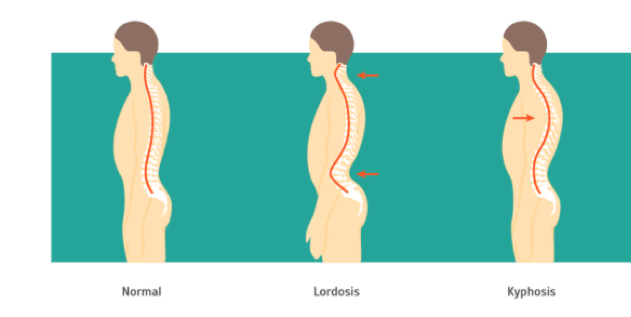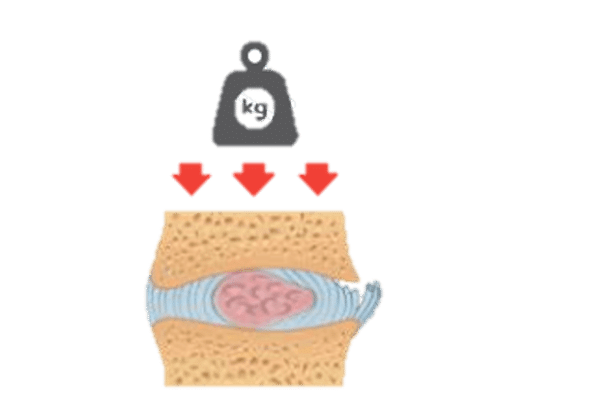Request Appointment
Enter your details and we will be in touch with you shortly;
Or call 08655885566 between 8 am and 8 pm.

Abnormal convexity of spine in thoracic and sacral region

Kyphosis symptoms are most visible in appearance itself, with the top arch of the back appearing excessively rounded, creating a hunchback or hump-like appearance. However, this is not the only symptom and patients may also observe the following:
 Professional diagnosis required
Professional diagnosis required Chronic, can last for years
Chronic, can last for years Treatable with 8 weeks of QI Spine Therapy
Treatable with 8 weeks of QI Spine TherapyKyphosis can occur for a variety of reasons, including disc degeneration, osteoporosis, or postural problems. The most common causes of kyphosis include the following:
 Professional diagnosis required
Professional diagnosis required Chronic, can last for years
Chronic, can last for years Treatable with 4 weeks of QI Spine Therapy
Treatable with 4 weeks of QI Spine TherapyTreatment for kyphosis vary among patients, depending on how severe the curvature is, and also on the prevalence of other symptoms like back pain. Surgical intervention is only recommended in rare cases when the curvature is over 70%.
Conservative treatments are considered to be the best option as they help to control pain as well as prevent the progression of the condition. These are a few of the treatments for kyphosis:
Kyphosis that is caused by a structural problem is often treated by wearing a special brace which stops or at least slows down the progression of the curve. This also helps to reduce the pressure and stress placed on the other structures of the back which in turn reduces back pain. Spine specialists will provide a brace that is custom-fitted to your body as this will improve the therapeutic effects of the brace.
Kyphosis can place a great deal of stress on the rest of the back and can even cause vertebrae to become misaligned. Spinal manipulation eases muscle tension and ensure that the vertebrae remain correctly aligned which reduces back pain.
Posture modification is an important part of managing kyphosis pain as bad posture can aggravate the condition and drastically increase the severity of the pain. A spine specialist will be able to look at your work and home environments and suggest changes that will promote good posture.
Smoking reduces the amount of oxygen that goes to the rest of your body, including your back. Several studies show that smoking increases the incidence and severity of back pain so spine specialists strongly urge their patients to completely quit cigarettes.
Patients with kyphosis who experience moderate or severe pain will benefit from nonsurgical spine treatments such as acupuncture, acupressure, and frequency specific micro current therapy. TENS (transcutaneous electrical nerve stimulation) is another effective method of pain control. This method uses mild electrical currents to reduce pain so unlike pain medications, it does not have any lasting side effects.
If your back pain is severe or if it increases, it could indicate that you have suffered a mild fracture. Fractures can aggravate kyphosis so please consult a spine specialist as soon as possible.
 Professional diagnosis required
Professional diagnosis required Chronic, can last for years
Chronic, can last for years Treatable with 4 weeks of QI Spine Therapy
Treatable with 4 weeks of QI Spine TherapyTreatment for kyphosis vary among patients, depending on how severe the curvature is, and also on the prevalence of other symptoms like back pain. Surgical intervention is only recommended in rare cases when the curvature is over 70%.
Conservative treatments are considered to be the best option as they help to control pain as well as prevent the progression of the condition. These are a few of the treatments for kyphosis:
Kyphosis that is caused by a structural problem is often treated by wearing a special brace which stops or at least slows down the progression of the curve. This also helps to reduce the pressure and stress placed on the other structures of the back which in turn reduces back pain. Spine specialists will provide a brace that is custom-fitted to your body as this will improve the therapeutic effects of the brace.
Kyphosis can place a great deal of stress on the rest of the back and can even cause vertebrae to become misaligned. Spinal manipulation eases muscle tension and ensure that the vertebrae remain correctly aligned which reduces back pain.
Posture modification is an important part of managing kyphosis pain as bad posture can aggravate the condition and drastically increase the severity of the pain. A spine specialist will be able to look at your work and home environments and suggest changes that will promote good posture.
Smoking reduces the amount of oxygen that goes to the rest of your body, including your back. Several studies show that smoking increases the incidence and severity of back pain so spine specialists strongly urge their patients to completely quit cigarettes.
Patients with kyphosis who experience moderate or severe pain will benefit from nonsurgical spine treatments such as acupuncture, acupressure, and frequency specific micro current therapy. TENS (transcutaneous electrical nerve stimulation) is another effective method of pain control. This method uses mild electrical currents to reduce pain so unlike pain medications, it does not have any lasting side effects.
If your back pain is severe or if it increases, it could indicate that you have suffered a mild fracture. Fractures can aggravate kyphosis so please consult a spine specialist as soon as possible.
 Professional diagnosis required
Professional diagnosis required Chronic, can last for years
Chronic, can last for years Treatable with 4 weeks of QI Spine Therapy
Treatable with 4 weeks of QI Spine Therapy


Have a question?
Ask our spine specialists
Who is a QI Spine Specialist?
A QI Spine Specialist is a medical expert with

Dr. Nidhi Sanghvi Shah

Dr. Manisha Moorjani

Dr. Shital Gaikwad

Dr. Richa Bhatia
9000 hours
of specialisation in treating back and neck conditions
32 hours
of spine physiotherapy specialisation methods in McKenzie concepts, Kinetic control, Neurodynamic solutions, Mulligan’s concepts
500 hours
and 6 months of QI Spine specialisation courses